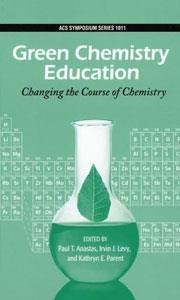Green chemistry education: changing the course of chemistry
Green chemistry education: changing the course of chemistry (ACS symposium series 1011)
Paul Anastas, Irvin Levy, and Kathryn Parent
Oxford, UK: Oxford University Press 2009 | 232pp | ?95.00
ISBN 9780841274471
Reviewed by James Clark

After giving a lecture about the need for industry to replace old, dirty chemical processes with greener alternatives, one individual pointed out that their chemists simply repeated what they had been taught.
The importance of green chemistry education has been recognised through a series of American Chemical Society symposia which form the basis of this book. Much of the work described is from US colleges although the global growth in green chemistry is illustrated on a map which unfortunately misses many European activities.
I was heartened to read that green chemistry can be a ’. fruitful discipline . that enhances one’s professional development’. That message should serve as a lesson for all educators - green chemistry teaching can be a rewarding experience for the teacher as well as the student. The enthusiasm of the authors is infectious but has led to some exaggerated statements such as ’green chemistry ... is making its way into all aspects of the chemical enterprise’; this is certainly a laudable aspiration but in my experience, far from reality. The green chemistry education in universities for example, ranges from none to full Masters degrees (of which there are now several in Europe).
If we are to get wider coverage then we must have a green chemistry toolkit of practicals, lectures, workshops and interesting case studies that help teach the fundamentals of all areas of chemistry.
While this book is interesting as a series of personal experiences it provides little actual teaching material. In the early days of green chemistry planning in the Royal Society of Chemistry, and as the Green chemistry journal and Green Chemistry Network were being born, we agreed that a measure of real success would be when dedicated journals and networks, or indeed any ’green chemistry’ label were no longer needed. When this happens, we will be able to say that green chemistry has made its way into all aspects of the chemical enterprise.












No comments yet